In Search of the Niinja (50 page)
Read In Search of the Niinja Online
Authors: Antony Cummins

‘Reins That Pull Together and Fill the Mouth’
1 Ring
2 2
Sun
1
Bu
3 This is a three foot cloth
4 Use Cloth
5 Make with cloth and double up
6 The same as the other ring
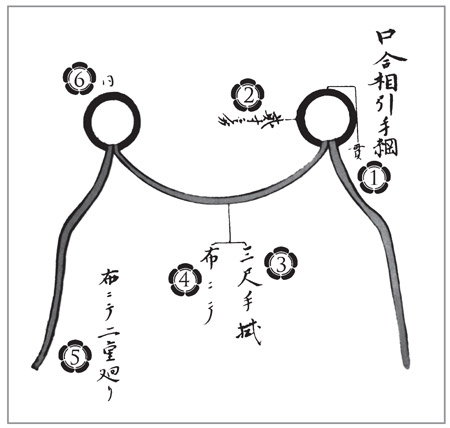
‘Spear Rest’
[As described above, this is most likely the ‘Spear Rest’ discussed in the
Bansenshukai,
however the full meaning is unknown.]
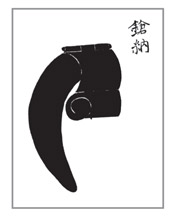
‘Sword Belt’
1 Two sided with tanned leather on the back and the front
2 Brass hook to be attached to the sash
3 Oral tradition
4 This leather is tanned on the back and the front
179
and is lined with woollen cloth or white [illegible text].
5 The leather can be made of good quality skin and should be 9
Sun
long, this is an oral tradition
6 The clasp
180
is an oral tradition
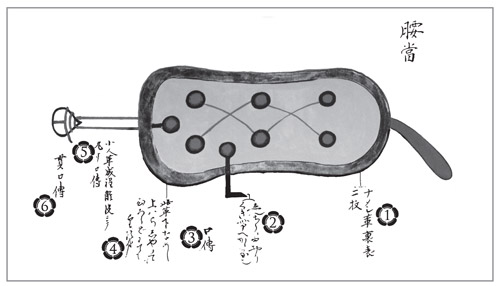
‘Water Flask’
1 The length should be one
Shaku
and the top should be made according to [illegible text].
3 Attach it to your belt and cover
181
with copper. Details on its construction are an oral tradition.
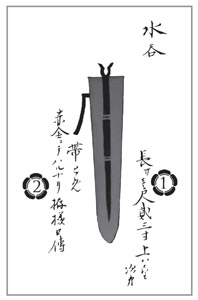
‘Horse Girth Band’
1 Tighten [with the two strings at the ring]. This is ‘Fast Riding Saddle’and also a double Horse Girth.
2 Ring: oral tradition

[Accompanying text]
There are various types of horse girth bands, such as the
Kanto-haraobi
, the
Kurishime-haraobi
, the
Neji-haraobi
, and the
Hayagura niju-haraobi
. Further information is an oral tradition.
[When a scout or mounted warrior pushed his horse to a fast pace, this tool was used to help strap him down in the saddle.]
‘The Horseback Lantern’
1 Oral tradition
[This is probably a torch that attaches to the rider behind the saddle and illuminates the area around him. It would render the rider visible, therefore it was probably used for riding at night and in a group.]
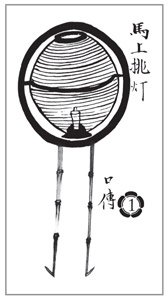
‘The Battle-Camp Water Flask’
1 Oral tradition
[What may appear to be a basic item to modern readers would have been an essential tool in Asian summer heat and a standard requirement for any scout who was out for days on end. There is no explanation for the black nodule on the right hand edge.]
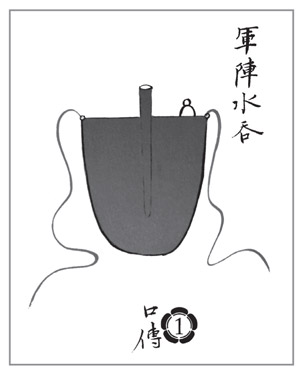
‘The Battle-Camp Water Bucket’
1 Supporting shaft
2 The bottom of this bucket is made of wood.
3 The sides of this bucket are made of cloth.
[This is a common medieval water bucket and is constructed of material and is collapsible, it is possible that this was taken with a rider to hold water for a horse or to take water to a makeshift camp when the mounted warriors were on the move.]
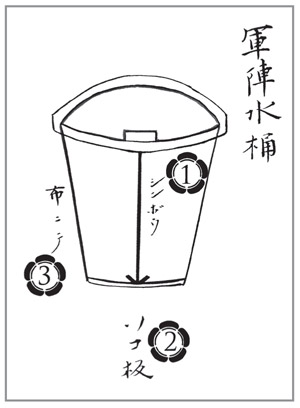
‘The Standard or Banner’
1 This is a
Gattari
fitting [to attach the standard to your back] This ‘
Gattari
’ attachment is an oral tradition.
2 This is the bottom cylinder housing for the banner.
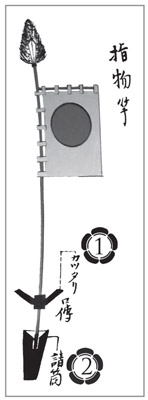
1 This tool is the same as the one above
2 This grip
182
here has oral traditions.
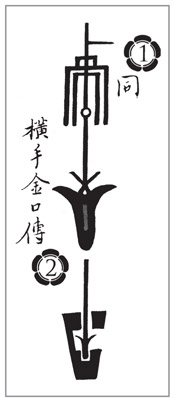
[These standards or banners would most likely be used in actual combat, as keeping a low profile in mounted scouting may not have been a high priority and generally, banners and standards are used so that commanders can identify sections of their troops in combat.]
‘The Floating Bridge’
This tool is made from a spear.
1 There is a ring near the top of the spear shaft.
2 These two red circles are ‘floating shoes’ and are secret.
3 There is a rope to hold on to.
183
4 This is the butt of the spear.
5 Here you will find the ‘pointing eye’.
184
[Floating bridges are without doubt connected to ninja and are mentioned in many manuals. However, this version appears to be a variation, as other floating bridges are normally anchored on the banks of a river. This device is a flotation aid for one man and could have been used either to cross over a river or to travel down river through into enemy territory. The construction of the two floats is unknown, however it is most likely lacquered and sealed leather or animal skin with a ‘stopper’ cap for filling with air.]
